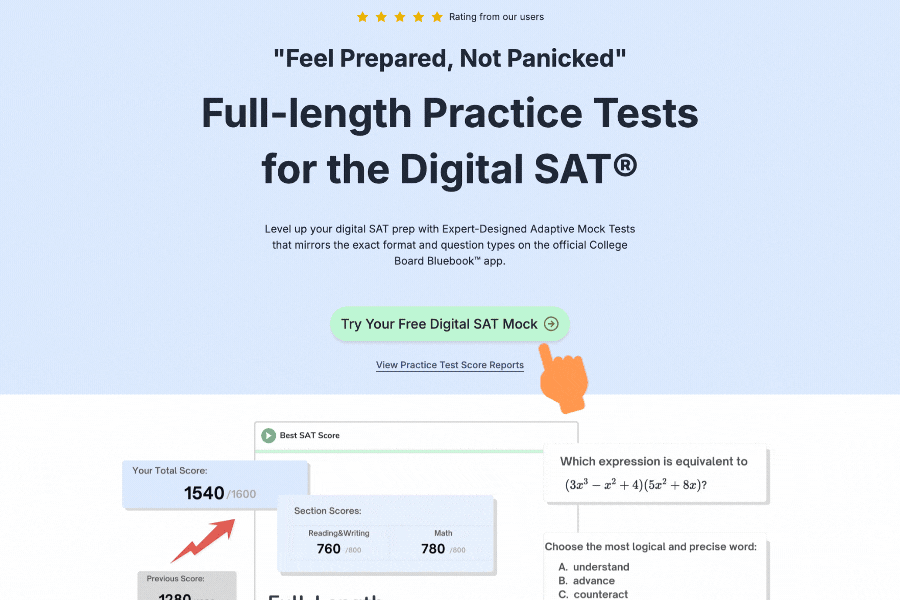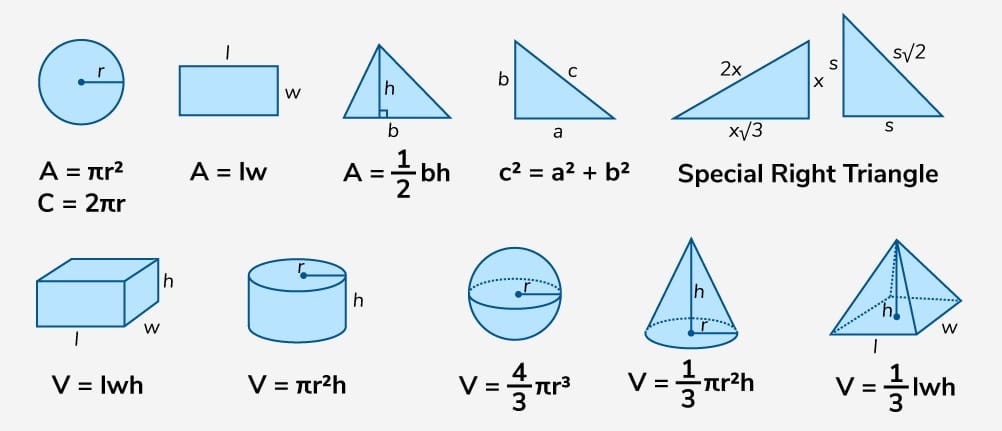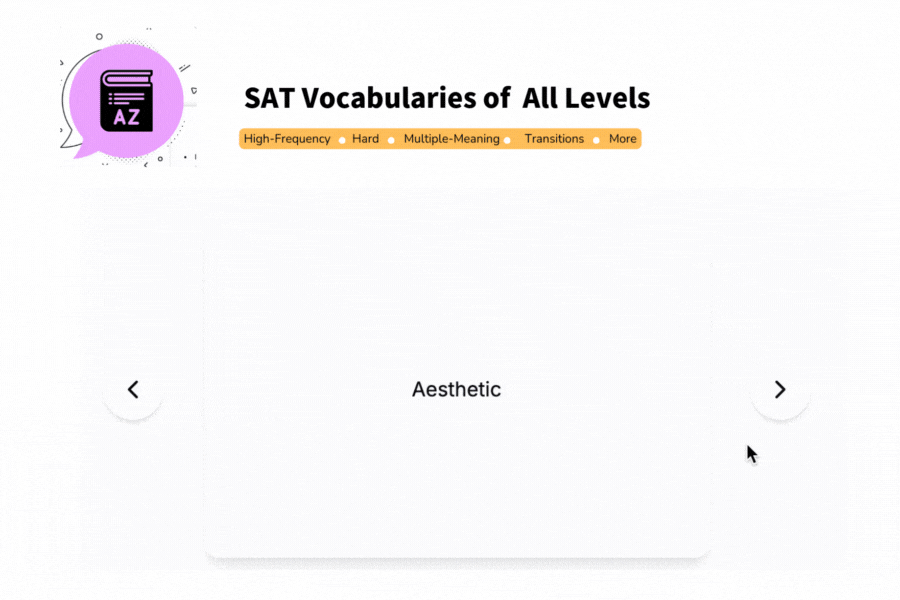SAT Question Bank
Comprehensive Practice Resource
Our comprehensive SAT Question Bank features carefully selected questions from thousands of past SAT exams, representing the most essential and frequently tested concepts. With 20 questions per skill in each domain, complete with detailed solutions and explanations, this resource is designed to boost your score by 200+ points through focused practice and deep understanding. Additionally, you can utilize our Flash Card learning system to further enhance your score.
Pro Tip: The key to mastering the SAT is not just practicing with any questions, but with the right questions. Our thoughtfully assembled question bank highlights the most frequently tested patterns and concepts, ensuring that within your limited prep time (it's possible to customize a personalized study plan), you focus efficiently on the material that matters most.
Question Bank Content
Reading & Writing
Information and Ideas
Craft and Structure
Expression of Ideas
Standard English Conventions
Math
Advanced Math
Algebra
Geometry and Trigonometry
Problem-Solving and Data Analysis
- Ratios, rates, proportional relationships, and units
- Percentages
- One-variable data: distributions and measures of center and spread
- Two-variable data: models and scatterplots
- Probability and conditional probability
- Inference from sample statistics and margin of error
- Evaluating statistical claims: observational studies and experiments
Free Full Length SAT Tests withOfficial-StyleQuestions
Practice with our full length adapive full testreal test-likequestions and proven300+points score boost

SAT Math Formulas Reference
Master these essential SAT Math formulas to boost your score. These formulas appear frequently in SAT Math questions and are crucial for solving geometry, algebra, and data analysis problems efficiently.

The number of degrees of arc in a circle is 360.
The number of radians of arc in a circle is 2π.
The sum of the measures in degrees of the angles of a triangle is 180.
Question Source and Difficulty Distribution
Our question bank is meticulously curated to provide you with the most authentic SAT practice experience. All questions are sourced from actual SAT exams administered in the past three years, ensuring you practice with the most current and relevant material.
For each skill area, we have carefully selected 20 questions that best represent the concepts and patterns you'll encounter on test day. This focused approach allows you to master each skill thoroughly while maintaining a manageable practice load.
Difficulty Distribution: To help you gradually build confidence and tackle increasingly challenging problems, we've structured the questions with the following difficulty distribution:
- 20% Easy questions - Perfect for building foundational understanding
- 30% Medium questions - Ideal for reinforcing concepts and developing problem-solving strategies
- 50% Hard questions - Essential for mastering complex problems and achieving top scores
Everything You Need to Know
What makes our Question Bank unique?
Our Question Bank is meticulously curated from over 10,000 real SAT questions, focusing only on the most representative and frequently tested patterns. Each question is handpicked by SAT experts to ensure you're practicing with the most relevant content. Unlike random practice questions, our bank specifically targets the core concepts and question types that consistently appear on the actual SAT.
How is the Question Bank organized?
The Question Bank is systematically organized by domains and skills, with 30 carefully selected questions for each skill area. For example, in Math, you'll find dedicated sections for Advanced Math, Algebra, Geometry, and Problem-Solving, each containing skill-specific questions. Every question comes with a detailed solution, common mistake analysis, and key concept explanations to ensure comprehensive understanding.
How can this Question Bank help improve my score?
By focusing on our curated questions, you can expect a score improvement of 200+ points. This is achieved through: 1) Exposure to the most representative question types, 2) Understanding common patterns and traps, 3) Learning efficient problem-solving strategies, and 4) Mastering key concepts through detailed explanations. Our data shows that students who complete the Question Bank typically see significant improvements in their test scores.
What's included in the explanations?
Each question comes with comprehensive explanations that include: 1) Step-by-step solutions, 2) Alternative solving methods, 3) Common mistake analysis, 4) Key concept reviews, and 5) Quick tips for similar questions. These detailed explanations help you not just answer the question correctly, but truly understand the underlying concepts and recognize similar patterns on test day.
How should I use the Question Bank effectively?
For maximum benefit, we recommend: 1) Start with a diagnostic test to identify your weak areas, 2) Focus on questions from your weakest skills first, 3) Thoroughly review explanations even for questions you got right, 4) Keep track of commonly missed concepts, and 5) Regularly revisit challenging questions. Consistent practice with our Question Bank, combined with careful review of explanations, typically leads to significant score improvements.
Master SAT withSmart FlashcardsSystem
Master essentialReading & Math fundamentalsand buildcore skillsto secure your base score

SAT Math: Time-Saving Strategies
Calculator vs. Mental Math
Using mental math instead of a calculator in the SAT Calculator-Permitted section can reduce overall completion time by 10-30%, depending on the question type and your proficiency level. Here's a detailed breakdown:
| Question Type | Mental Math | Calculator | Mental Math Advantage |
|---|---|---|---|
| Single Digit Multiplication (e.g., 7 × 8) | 1s | 3s | 67% faster |
| Single × Double Digit (e.g., 7 × 12) | 2s | 4s | 50% faster |
| Simple Addition/Subtraction (e.g., 374 + 126) | 2s | 4s | 50% faster |
| Multiplication by 5 (e.g., 85 × 5) | 2s | 4s | 50% faster |
| Multiplication by 25 (e.g., 32 × 25) | 3s | 5s | 40% faster |
| Multiplication Tables (e.g., 25 × 16) | 3s | 5s | 40% faster |
| Decimal Operations (e.g., 3.27 × 4.9) | 6s | 4s | Calculator faster |
| Complex Calculations (e.g., 87 × 76) | 8-12s | 5s | Calculator faster |
Overall Time Savings in Calculator Section
- The Calculator section contains approximately 20-25 questions requiring calculations
- Calculator usage typically takes 10-15 minutes total
- Proficient mental math can save 3-5 minutes on simple calculations
- Complex calculations still require calculator use
- Estimated time savings: 10-30% (approximately 2-5 minutes)
Key Factors
- Mental Math Proficiency: Greater advantages for those skilled in decomposition and speed calculation techniques
- Question Complexity: Calculator maintains advantage for questions involving decimals and square roots
Strategic Recommendation
The optimal approach for the SAT is to combine mental math with calculator use:
- Use mental math for simple integer operations (20-30% faster)
- Rely on calculator for complex calculations
- This hybrid strategy can save 10-30% of calculation time (2-5 minutes)
Multiplication Tables: A Critical Foundation
Mastering multiplication tables (1-12) is fundamental for SAT Math success. Here's why memorizing these tables is crucial:
- Speed Advantage: Instant recall of multiplication facts saves 2-3 seconds per calculation compared to calculator use
- Mental Bandwidth: Automatic multiplication recall frees up mental resources for problem-solving strategy
- Pattern Recognition: Familiarity with multiplication patterns helps in identifying shortcuts and estimating answers
- Error Reduction: Less reliance on calculator input reduces the chance of typing errors
Practice Tip: Focus on mastering these specific multiplication combinations as they appear frequently in SAT questions:
- Multiples of 5 and 25 (for percentage calculations)
- 11's pattern (useful for quick mental multiplication)
- 12's table (common in unit conversion problems)
- Square numbers up to 15² (frequently used in geometry)
Multiplication Table (Traditional Format)
| 1×1=1 | ||||||||
| 1×2=2 | 2×2=4 | |||||||
| 1×3=3 | 2×3=6 | 3×3=9 | ||||||
| 1×4=4 | 2×4=8 | 3×4=12 | 4×4=16 | |||||
| 1×5=5 | 2×5=10 | 3×5=15 | 4×5=20 | 5×5=25 | ||||
| 1×6=6 | 2×6=12 | 3×6=18 | 4×6=24 | 5×6=30 | 6×6=36 | |||
| 1×7=7 | 2×7=14 | 3×7=21 | 4×7=28 | 5×7=35 | 6×7=42 | 7×7=49 | ||
| 1×8=8 | 2×8=16 | 3×8=24 | 4×8=32 | 5×8=40 | 6×8=48 | 7×8=56 | 8×8=64 | |
| 1×9=9 | 2×9=18 | 3×9=27 | 4×9=36 | 5×9=45 | 6×9=54 | 7×9=63 | 8×9=72 | 9×9=81 |
Note: This traditional format shows each multiplication fact once, making it more efficient for memorization. The empty spaces in the upper right indicate that those combinations are already shown in the lower left (since multiplication is commutative).
Comprehensive Skill Tutorials
Equivalent Expressions
Learn to rewrite and simplify algebraic expressions using properties of exponents, factoring, and rational expressions to solve problems efficiently.
Nonlinear Equations
Develop skills in solving quadratic, exponential, and other nonlinear equations in one variable, as well as systems of equations involving nonlinear relationships.
Nonlinear Functions
Analyze the key features of quadratic, exponential, and other nonlinear functions, including their graphs, transformations, and real-world applications.
Essential SAT Prep Tools
Maximize your SAT preparation with our comprehensive suite of tools designed to enhance your study experience and track your progress effectively.
Personalized Study Planner
Get a customized study schedule based on your target score, available study time, and test date.
Expert-Curated Question Bank
Access 2000+ handpicked SAT questions with detailed explanations, organized by topic and difficulty level.
Smart Flashcards
Create and study with AI-powered flashcards featuring spaced repetition for optimal retention.
Score Calculator
Convert raw scores to scaled scores instantly and track your progress towards your target score.
SAT Skills Lessons
Master each SAT skill with progressive lessons and comprehensive guides, from foundational concepts to advanced techniques.
Full-Length Practice Tests
Experience complete SAT exams under realistic conditions with adaptive difficulty.
Pro Tip
Start your SAT prep journey by creating a personalized study plan 3-4 months before your test date. Use our time management tools to master pacing, combine mini-tests for targeted practice, and gradually progress to full-length practice tests. Regular review with flashcards and consistent practice with our question bank will help you stay on track with your study goals.